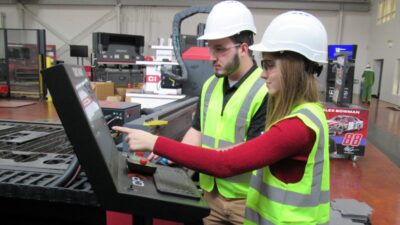General Motors found that instilling safety in all employees and using safety automation products lowered risk and injuries. GM created a risk assessment program to help identify potential hazards, determine safety automation needs, and ensure that machines and equipment met applicable code requirements. Findings helped cost justify investments in innovative safety solutions.

Mike Douglas speaks with pride as he recalls the journey General Motors took to attain one of the world’s best manufacturing safety records. In 1993, the incident rate in the company’s North American facilities was 29 per 100 employees, and the lost workday case rate was 4.5 per 100. Those numbers were in line with other U.S. car makers, but higher than the nation’s top industrial performers.
By 2008 (the latest year for which figures are available), GM’s lost workday rate had dropped dramatically—to 0.14, with a 1.69 injury rate. How did the automaker do it? “Making safety—and our commitment to safety—visible to everyone at every level was critical to our success,” said Douglas, the company’s senior manager and consultant, Global Health & Safety, Design, Standards, and Technologies. “You have to consistently overcome inertia and indifference by actively targeting safety issues every day.”
GM executives and union representatives partnered to create a safety culture that reached from the shop floor to the top floor. They established safety task forces, improved training and education for all employees, and partnered with leading standards organizations and associations. In addition, GM created a risk assessment program to help identify potential hazards, determine safety automation needs, and ensure that machines and equipment met applicable code requirements. The risk-assessment findings helped cost justify investments in innovative safety solutions.
When considering safety, it is critical to identify the “tasks” people perform, and what actions need to be taken so that those tasks are performed safely, Douglas explained. From there, designers can look at those same tasks and determine how much time they require, and how that time impacts production throughput. Using this approach in the mid 1990s, for example, GM saved several million dollars annually across five plants by installing safety controls from Rockwell Automation for tasks routine and integral to production. At the same time, those new safety controls helped reduce downtime. In fact, the safety features enabled plant throughput to increase by four additional vehicles every five hours, which in turn increased GM’s bottom line.
That same risk assessment process also led to the idea of integrating safe and standard control to streamline hardware, wiring, and productivity costs. Historically, manufacturers used one controller to run standard automation functions, and added safety relays to protect workers. The relays shut down the entire system in the case of a fault or demand, but significantly hampered productivity. With the advent of safety PLCs, safety relays gave way to a programmable approach that incorporates separate controllers—standard and safe—with different software, training, and components.
At the outset of its safety journey, GM focused on programmable controllers to reduce the cable and labor costs associated with the hardwiring required with safety relays. Then, the automaker worked with longtime supplier Rockwell Automation to develop and implement what became the Allen-Bradley GuardLogix controller.
With a SIL (safety integrity level) 3 functionality rating, GuardLogix controllers help integrate safe and standard control. They are part of the Rockwell Automation Integrated Architecture system, which helps improve information-sharing, provide multi-disciplined control, reduce training costs, and accelerate programming and commissioning. The automation system’s operational intelligence and diagnostics also help improve equipment productivity and lifespan, while reducing downtime.
Using GuardLogix controllers instead of traditional safety relays helped GM greatly reduce installation and debug times for new body shop equipment. Previously, wiring for a typical five-robot cell required 640 wires/cables. The GuardLogix system reduced wiring to a five-wire cable. In addition, “plug and play” functionality and debug features reduced installation and maintenance time and costs.
Today, Douglas and his GM counterparts continue their safety journey, working with Rockwell Automation to implement new safety automation solutions that help trim costs, increase production and, most importantly, keep their people safe. “Not a day that goes by that I don’t equate a savings in some shape or form with our safety systems,” Douglas said. “At GM, who’s responsible for safety? It’s simple—everybody is. We live and work by the principle that all incidents can be prevented.”
Also read:
– Machine safety advice: Think beyond the safety device, Rockwell Automation says;
– Reliable Operations for Perishable Products;
– Safety: Tale of Two Applications;
– Control Engineering Machine Safety Blog.
– Edited by Jeanine Katzel, Control Engineering contributing editor, Home, Rockwell Automation, Cleveland, OH — Select a Region | Rockwell Automation; General Motors Co. — General Motors: Pushing the Limits of Transportation & Technology.



